Wednesday, June 15, 2016
Historical Background of EHCC
"Eastern Himalayan Church Council (EHCC), at Lal Khoti, Kalimpong, 1958" "EHCC Committee at Kalimpong in 1941"
"EHCC Committee at Kalimpong in 1941"
Around 1869 the Church of Scotland started it’s religious and charitable trust in the province of Bengal. The Foreign Mission Committee of the Church of Scotland sent its missionaries to India and finally in the areas of Eastern Himalayas. In 1870 Rev. William Macfarlane came to Darjeeling from Gaya. He was followed by other missionaries and they ventured to different localities of the area and established dispensaries, schools and Churches. Eventually its work was extended to the terai and plains of Jalpaiguri.
At different times various sects and denominations in the Christian religion originated mainly on the basis of diverse convictions and missionaries and priests belonging to different denominations started propagating their faith, practices of doctrines among the people under different names suggestive of their places of origin and specialists of faith, practices and doctrines and every such denomination is also commonly known as Church.
The Churches established in different areas were put under Missions of respecting areas like Darjeeling, Kalimpong etc. Later these Missions together were united to constitute Eastern Himalayan Church Council a larger body under the FMC of Church of Scotland.
In or about 1924, the Presbyterian Churches and Congregational Churches started in the Northern parts of India united to go in one organic unity to form a now denomination called the United Church of Northern India (UCNI). The said association UCNI has got it’s own constitution known as “Blue Book”. At that time the Missions of Church of Scotland became its member and the Eastern Himalayan Church Council with its headquarter in Darjeeling was formed as a Church Council of the U.C.N.I.
The Church of Scotland acquired various immovable properties in different part of North Bengal including the District of Darjeeling and Jalpaiguri for their religious and charitable works. The Church of Scotland Trust, a body duly incorporated in Scotland and under the Church of Scotland Trust order confirmation Act 1932 and also duly incorporated under the Indian Companies Act 1913 and constituted as a Trustee on behalf of the Church of Scotland.
EHCC having it’s headquarters at Darjeeling used to administer the properties belonging to the Church of Scotland Trust in the District of Darjeeling and Jalpaiguri.
In or about 1970 a new denomination called the Church of North India came into being who claimed that the following six denominations gave with to C.N.I. The Baptist Churches in Northern India, The Church of Brethen in India, The Disciples of Christ Church, The Church of India (the Church of India, Pakistan, Burma and Ceylon which was originally known as the Anglican Church or the Church of England in India), The Methodist Church (British and Australian conferences) and the United Church of Northern India.
The merger/amalgamation is absolutely illegal, invalid and imperative in law and has been challenged in different courts of law.
At no point of time the CNI had any unity of faith with any of the six denominations and specially with that of UCNI in relation to creed, confession, formulation etc.
The congregation of EHCC came to realise the fact that they had no spiritual compatibility in the new set up in the matters of faith,worship, practice and tradition since they believed in the order and faith as propounded in the constitution of UCNI called Blue Book and whereas CNI has introduced system which were quite alien and averse to the Presbyterian system.
These facts and circumstances in or about 1st May 1993 the members of the EHCC decided not to continue relationship with CNI and accordingly by a resolution declared and disassociated themselves from CNI and decided to reaffirm to their old Presbyterian faith and order and revive and rejuvenate their time honored old traditions and heritage both spiritual and temporal under their original organisation that is UCNI and also to revive their previous identity as the EHCC.
The Scottish Churches' Work Abroad
The role of Missionaries of Darjeeling hills in the growth of the church in Nepal
Scotland in India
All the branches of the Scottish Church have had their part in the evangelisation of India, drawn thither by the irresistible attraction of the country, and impelled also by a sense of our responsibility for the moral and spiritual well-being of Britain’s great Eastern dependency. Scotland’s most distinctive contribution has probably been along the line of educational missions, of which some account has already been given. Before the Disruption of 1843, work had been begun in the three great cities. Bombay was the first to be occupied in 1823, though the College was not founded till 1835. Duff began his great educational work in Calcutta in 1830, and Anderson in Madras in 1837. After the Disruption, the three Colleges continued their work under the auspices of the Free Church. Later, the Church of Scotland reoccupied Duff’s old college and soon made it a flourishing educational centre. In due time the two Calcutta colleges were happily amalgamated under the name of the Scottish Churches’ College. The colleges at Madras and Bombay have had an equally prosperous career, and it is not too much to say that they have been one of Scotland’s finest gifts to India.
Besides the colleges, other missionary agencies are at work in and around the three great cities. Street preaching, medical missions, schools, and rescue work are carried on as opportunity offers. Up the Hugli, from Calcutta, a successful mission has been, established in the district between Chinsurah and Kalna. South-west of Madras, Conjeeveram, the holy city of South India, has been occupied, and, in addition to other mission work, a leper colony has recently been taken over. At Chingleput, in the same district, a very notable work has been carried on among the low caste people who, here as elsewhere, are crowding into the Christian Church.
Throughout the rest of India the Scottish Churches are at work in five different fields. These are the Maratha country, the Panjab, Rajputana, Santalia, and the Eastern Himalayas.
One more field of Scottish missionary endeavour in India remains to be mentioned, namely, the Eastern Himalayas. In 1870 the Church of Scotland began a mission at Darjeeling. The first missionary was Mr. William Macfarlane, who laboured for years without visible success and then began to reap the harvest of his faith. After ten years he left Darjeeling to the colleagues who had joined him and opened a new station twenty-five miles east at Kalimpong. Three years later he organised the Scottish Universities Mission in Independent Sikkim, the territory immediately to the north.
The situation of the Eastern Himalayan Mission is in some respects unique. It is perched among the mountains within sight of the loftiest peaks in the world; below are the sweltering plains of India, above towers the grandeur of the snowy range. It also lies at a point where Western civilization, rolling proudly over many lands, comes up against a dead wall. Darjeeling is in more senses than one the ne plus ultra of health resorts. Down below in the hot and steamy tea gardens of the Dooars and far across the plain of the Ganges to Calcutta, sunbaked planters and engineers and Government officials sigh for a sight of Darjeeling, and a breath of its mountain air; over the mountains behind, in Tibet, Nepal, and Bhutan, a jealous watch is kept against the intrusion of the foreigner. The district occupied by the Mission may roughly be compared to a wedge driven northward into the heart of these three great closed lands.
Corresponding to its unique situation, the work of the Mission is very varied in character. It ministers to the spiritual needs of the British residents in the district, especially to the Scots tea-planters in the Dooars, from whom it receives substantial help. Dr. Graham of Kalimpong is a name to conjure with in all that part of India. Besides preaching and medical work among Europeans and natives, he founded the St. Andrew’s Colonial Homes for AngloIndian children. He also organised the Kalimpong Mission Industries Association for the development of native industries. The number and diversity of languages among the hill tribes presents a formidable difficulty, but as converts are steadily gathered in, with here a Tibetan and there a Nepalese, and as rumours of the Mission penetrate far away into the hills, the day draws nearer when a great and effectual door will be opened for the Gospel into the inmost heart of Asia.
These Scottish Missions, widespread and varied in their operations, commanding the devoted services of over three hundred missionaries, are yet but tiny spots of light in the immensity of India’s millions. Other Missions are at work in the same great field, and the number of Christians is about five millions. Among the various Protestant agencies there is the happiest spirit of cooperation and unity. No one wishes to repeat in India the ecclesiastical divisions of the West, and already there has been constituted the United Church of India, with only the necessary geographical division of North and South. But the regenerating influence of the Gospel is felt in India far beyond the limits of the Indian Church. Christian moral and social ideals are steadily gaining the ascendant, and are subtly permeating the minds of Hindus and Mohammedans. Every careful observer is convinced that Christ is coming to His own in India, and none can tell how soon he may be openly acclaimed as the fulfillment of the religious aspirations of the ancient East.
This is the gift of Christian Missions to India, and it may be found in the end to be a greater gift than all that the Government has done. Both agencies are working for the same high end, and their relations have never been better expressed than by Sir Charles Elliott, Lieutenant-Governor of Bengal, in a speech delivered at Darjeeling. "As head of the Government, I feel that the missionaries are, so to speak, an unrecognised and unofficial branch of the great movement in which we are all engaged, and which alone justifies our presence in the country. They occupy a field which the officers of Government are unable to take up. We are doing a great work in spreading the blessings of civilisation, making life and property secure, teaching the rule of law, and encouraging the growth of education, but we cannot directly touch on religious subjects. . . . Yet we know right well that the only hope for the realisation of our dream, and for the true elevation and development of the people, lies in the evangelisation of India, and we know that the people who are carrying on this work are the missionaries. It is they who are filling up what is deficient in the efforts of Government, by devoting their lives and their labours to bringing the people of India to the knowledge of Christ."
Until recently Nepal was the world’s only Hindu kingdom.The mighty Himalayas and the fact that Nepal was a closed land until the middle of the twentieth century enticed many, but from 1881 to 1925 only 153 Europeans are known to have visited Nepal and none became a resident.
This tiny mountainous country, sandwiched between India and Tibet, had resisted the might of the British Empire since King Prithvi Narayan Shah from Gorkha (hence “Gurkhas,” the renowned soldiers) unified the country into one kingdom in 1769. From 1848 until the middle of the twentieth century, the country was controlled by the Rana prime ministers, who had usurped the monarchy and had vested interests in keeping the world out. Their century of control was ended by an Indian-facilitated coup on February 16, 1951, that placed King Tribhuvan Shah in power.
The earliest recorded entry of Christians into Nepal was the visit of a Father Cabral, a Jesuit priest, in 1628. Capuchin monks were given permission by the Malla rulers to reside in the Kathmandu valley in 1715, but they were forced to leave by Prithvi Narayan Shah in 1769. The few national Christians, expelled at the same time, migrated to Bihar, India.
For almost two centuries Nepal was totally closed to any Christian presence or influence.
The revolution in 1951 was a turning point in the country’s development and in its openness to the outside world. Surprisingly, part of this story, the founding and growth of the church in Nepal, which is among the fastest growing anywhere in the modern world, has been recorded in only a handful of books.
From just a single secret Christian residing in Nepal in 1951, the number of Nepali Christians grew to about 40,000 baptized believers by 1990 and has increased more rapidly since then.
Estimates of the number of Nepali Christians vary widely, and government census figures have been unreliable. The most comprehensive survey of churches and Christians in Nepal was conducted by the Nepal Research and Resource Network. Begun in 2001 with the results published in 2007, the survey covered all seventy-five districts of the country. It showed a total of 2,799 churches and 274,462 baptised church members.
The survey counted 379,042 persons attending churches and presumed to be Christian; this number equals about 1.5 percent of Nepal’s population. Ten percent of the churches have sent out a missionary or evangelist, and one out of five churches has planted one or more daughter churches.
From the later nineteenth century numerous Protestant missions and missionaries in northern India were poised to enter Nepal when the opportunity came.
Prior to 1950 all the towns underlined (and more) had ongoing mission work among the itinerant Nepalis who crossed the Indo-Nepal border.
Four accounts, from among many more, underscore the high degree of anticipation and vision present during what Cindy Perry calls the “century of preparation.”
Following the visits by the Jesuit and Capuchin monks, other significant factors spanning more than a century helped to prepare for entry of the Christian Gospel into Nepal. For one thing, Protestant interest in Christian mission to Nepal has been present from the time of William Carey. The Serampore translation of the New Testament into Nepali, completed in 1821, was superseded only when the British and Foreign Bible Society’s Nepali translations of the New Testament (1902) and the Old Testament (1914) were completed.
Although in 1950 only 2 percent of Nepalis were literate, Christian literature had been used sporadically during the nineteenth and twentieth centuries to penetrate the border, despite laws that prohibited its sale, possession, or use within Nepal.
Darjeeling, on the eastern border of Nepal, was developed by the British, and a large community of Nepalis settled there to labor in the tea plantations. William MacFarlane, a Church of Scotland missionary, began the Eastern Himalayan Mission in 1870, a work active in education, Christian literature, Bible translation, and village evangelism. All were important foundations for the future as the Darjeeling and Kalimpong region became the main center for the nascent Nepali church.
Another group was the Australian Nepalese Mission (ANM), which began in a prayer meeting in Fitzroy, Melbourne, in 1911.
Founding missionary John Coombe with his wife, Lillian, and two children in 1917 established a base in Ghorasahan, Bihar, near the Nepal border. Although not one of the small band of ANM missionaries ever entered the closed land just across the border, their focus for three decades was on Nepal. They were typical of other missionaries and groups that, though seemingly insignificant, served faithfully in anticipation of Nepal’s border opening.
A third group was the Regions Beyond Missionary Union (RBMU), along with the Raxaul Medical Mission. Work by RBMU commenced in Bihar in the late nineteenth century, but the missionaries’ eyes were fixed on Nepal. The railhead border town of Raxaul, directly south of Kathmandu, was chosen as the site for Duncan Hospital, established in 1930 by Dr. Cecil Duncan (son of a missionary in Darjeeling). The site was well chosen and Duncan Hospital subsequently played a vital role in the entry of both church and mission into Nepal.
Finally, mention must be made of Dr. Kitty Harbord, the Nepal Evangelistic Band (NEB) at Nautanwa, another railhead, and the Nepal Border Fellowship (NBF). Harbord, of the Zenana Bible and Medical Mission (later Bible and Medical Missionary Fellowship, and now Interserve), opened a dispensary at Nautanwa in 1927. She recruited Dr. Lily O’Hanlon and Hilda Steele, who in 1943 founded the Nepal Evangelistic Band (now the International Nepal Fellowship). NEB was later, in 1952, to pioneer the move into Pokhara, west of Kathmandu. Harbord’s article “The Closed Land of Nepal: A Modern Jericho” (1939) influenced many, including Jonathan Lindell, and—building on conferences organized by Cecil Duncan in Raxaul in 1934 and 1937—led to the formation of the Nepal Border Fellowship.
The NBF was a loose association that brought various missions along the Nepal border together for encouragement, planning, prayer, and cooperation in terms of a Statement of Aims (May 17, 1948), a literature committee, and an advisory council. Later mission collaboration in Nepal grew from seeds sown in these conferences.
Nepali Christians and the Darjeeling Church
Key Nepali men and women became Christians during the “century of preparation.” One was Chandra Leela, the daughter of the Brahmin priest to the royal family in Kathmandu. Born in 1840, married at the age of seven, widowed at nine, and orphaned at fourteen, she became a sunyasi (Hindu holy woman) and for seventeen years searched the depths of Hinduism in her quest for solace and peace. Eventually she abandoned her quest but soon after met a young girl with a Bible.
After reading the Bible she became a Christian and went back to Kathmandu to speak of her new faith. She baptized her older brother shortly before he died, but then returned to India as an itinerant evangelist until her death.
Another early Christian was Ganga Prasad Pradhan, who was born into a wealthy Newar family in Kathmandu in 1851. When he was ten his father took him to Darjeeling to join his older brother in MacFarlane’s school, where Ganga Prasad was educated and converted, which led to a remarkable life of Christian service. He was “the first ordained Nepali pastor, translator of the Nepali Bible (completed in 1914 after forty years of labor—he was made a life governor of the British and Foreign Bible Society), pioneer in Nepali literature, and owner of the first Nepali press.”
In 1914 Ganga Prasad returned with his extended family to Kathmandu to establish a Christian presence there, but they were expelled by the Rana rulers with the words, “There is no room for Christians in Nepal!” A great legacy of Ganga Prasad was a hymn he wrote that for fifty years expressed the expectant prayers of the waiting clusters of missionaries and exiled Nepali Christians—“Prabhu arji suni leu, Gorkhali le mukti paune dhoka kholi deu . . .”
Lord, hear our prayer, open the door of salvation for the Gorkhalis. . . . Show us the way by a cloudy, fiery pillar. . . . There are cities—Thapathali, Bhatgaon, Patan, Kathmandu, Our prayer is to make them your devotees. Up, brothers, we must go, leaving wealth, home, people, and comfort, To do this holy task.
Forty-three years after Ganga Prasad had been expelled, his great-grandson Rajendra Rongong, Robert Karthak, and a small group of Darjeeling Christians entered Kathmandu with a strong sense of missionary calling instilled by RBMU missionary Elisabeth Franklin. And forty years later, in 1997, Rajendra Rongong and Robert Karthak were the key persons to lead one of the earliest Nepali missionary teams into Myanmar, where they helped establish the Myanmar Gurkhali Christian Fellowship.
Buddhi Singh, a humble watchmaker from eastern Nepal who was converted in Darjeeling by Ganga Prasad, was for many years an itinerant village evangelist with the Gorkha Mission, an indigenous Nepali mission founded by Darjeeling Christians in 1892 to evangelize Nepalis. In his later years he influenced the young David Mukhia, who in 1952 became the first pastor in Nepal, at the Ram Ghat Church in Pokhara.
Colonel Nararaj Shamsher Jung Bahadur Ranawas a member of the Rana aristocracy who retired from the army and lived in the Terai region, not far from Raxaul. He visited Duncan Hospital with his sick grandson, met Ernest Oliver (then field leader of RBMU but later a founder of the United Mission to Nepal and its first executive secretary), and became a secret believer. The Colonel Sahib (as he was known) was baptized by Oliver on Easter Sunday, 1952, and was instrumental in hosting the first church services in Kathmandu in his home there in April 1953. He was also a major contributor to the revised translation of the entire Nepali Bible, published by the Bible Society in 1977.
Chronologically, the first group consisted of foreign Christians entering from India, beginning with Father Moran, a Jesuit priest working in Patna, Bihar, who established St. Xavier’s School on the edge of the Kathmandu valley in July 1951. In 1952 the Nepal Evangelistic Band in Nautanwa was given permission to establish medical work in Pokhara, and in October Dr. O’Hanlon and Hilda Steele, with four expatriate colleagues and five Nepali Christians, including David and Premi Mukhia, trekked for nine days from Nautanwa to reach Pokhara. The “Shining Hospital” soon became renowned, and the mission later developed into the International Nepal Fellowship (INF). Its work continues to be primarily medical, but it has spread and diversified through many parts of western Nepal.
Formation of the United Mission to Nepal (UMN) came about through several remarkable coincidences. During the 1951 revolution, fighting took place just over the border from Raxaul, and wounded combatants from both sides were treated at Duncan Hospital. As a result of this service, after the revolution Dr. Trevor Strong and Ernest Oliver were invited by His Majesty’s Government of Nepal (HMGN) to visit Kathmandu to explore the possibility of mission work.The second group contributing to the formation of the church in Nepal consisted of Nepali Christians, including a small but significant contingent from the Darjeeling-Kalimpong region.
While the foreign missions were constrained from evangelizing and church planting by the terms of their agreements with the government, the Nepali Christians began to engage in Christian outreach and to form small congregations of believers.
Nepal’s first church was formed at Ram Ghat, Pokhara, in 1952 with David Mukhia as pastor. Others followed in the Kathmandu valley. Tir Bahadur became the pastor at Bhaktapur in 1954. Rongong and Karthak’s small group that arrived from Darjeeling in 1956 appointed Robert Karthak as pastor the following year. This group developed into the Nepali Isai Mandali, commonly known as Gyaneshwar Church, which today is the largest congregation in Nepal.
Other Darjeeling Christians became an integral part of the work of the UMN (United Mission to Nepal) in remote projects and were instrumental in establishing small congregations that have continued. Many have grown into substantial churches, and several have multiplied.
A dearth of trained leadership arising from inadequate opportunities in Nepal for pastoral and theological training is a matter of concern. Only a handful of Nepalis possess advanced training in theology. Ramesh Khatry was the first Nepali to earn a Ph.D. in New Testament studies, from Oxford University. He founded the Nepal Bible Ashram and heads the fledgling Association for Theological Education in Nepal, which commenced a B.D. program under Serampore University in July 2005. He also writes commentaries in Nepali.
The Nepali church continues to grow outside Nepal as well. The Nepali diaspora is estimated at 10 million, and Nepali congregations meet in many cities of India and in other countries.
Cindy Perry and colleagues in Himalayan Ministries (now HIMServe), based not far from Darjeeling, pioneered work among the Nepali diaspora.Several factors present during the three decades 1960–90 helped to form the character of the Nepali church and contributed to its growth and spread.First, there was an unprecedented degree of cooperation among various Christian groups, including those from Darjeeling and Kerala, together with expatriate missionaries. The NCF promoted unity and the church remained nondenominational.
Second, rapid development in Nepal, encouraged by His Majesty’s Government of Nepal, resulted in openness among the common people to new things. The expansion of missions, especially the UMN, into remote corners of Nepal inevitably resulted in new fellowships and churches springing up. At the same time the restrictions and constraints imposed by the government on missions and missionaries ensured the independence of these churches, and this independence was intentionally encouraged by mission leaders.
Third, the prohibition of conversion and the reality of persecution from the outset prevented nominalism and kept the church strong. Oppression of Christians increased in the late 1980s, along with widespread political agitation against the government.
Fourth, most converts were young, vigorous, and vibrant, with a keen sense of evangelistic outreach to the majority society.
Also, family conversions were not uncommon, and mass conversions occasionally took place among tribal groups (e.g., the Tamangs of Dhading District).
Fifth, retired Gurkha servicemen who had converted to Christianity while in the Indian or British army returned to their villages and established small Christian communities.
Sixth, new Christians were trained in India at Mirik Bible School in Darjeeling and Union Biblical Seminary in Pune to fill the need for pastors and church leaders. Locally, the NCF sponsored short-term training schools and conferences. Seventh, several para-church groups, especially student and youth organizations, worked alongside the churches to spur evangelism and to support new Christians. The women’s movement of the early 1980s resulted in the first nationwide women’s conference in 1985, more than 300 women’s prayer groups, and their increasing involvement in churches across the country.Eighth, Christian literature, including translation of portions of Scripture into several tribal languages by SIL/Wycliffe and the translation released by the Bible Society in 1977 of the whole Bible in Nepali, spread the Christian message. Radio ministries such as the Far East Broadcasting Company and Trans World Radio transmitted the message. Bible correspondence courses offered by the Nepal Gospel Outreach Center and others provided instruction to thousands of new believers.Ninth, the Nepali songbook brought together various earlier collections of indigenous songs as well as hymns translated from English and Hindi.
The predominant use of indigenous songs and tunes reflected the general pattern of indigenous worship that included such culturally appropriate practices as meeting on Saturdays (Sunday being a working day in Nepal) and gender-segregated seating on the floor, often in ordinary village homes.This article by John Barclay on the title "The Church in Nepal: Analysis of Its Gestation and Growth" is based on work done at the Bible College of Victoria in 2003 as part of an Australian College of Theology D.Min. course on church growth. Extensive reference was made to archival documents in the Nepal Church History Project (NCHP), Centre for the Study of Christianity in the Non-Western World, New College, University of EdinburghMaterial taken from International Bulletin of Missionary Research, Vol. 33, No. 4Resource: Cindy Perry, A Biographical History of the Church in Nepal, (Kathmandu: Nepal Church History Project, 1990)
Further A book titled "The United Church of Norther India Survey 1968" published by GA of UCNI states that it was not possible for the Team to visit this Church Council area, but the Church Council Secretary met the Director of the Team and questionnaires were returned by 12 congregation and 19 ministers. The following notes are compiled from these sources.
Partner Church: The Church of Scotland.
History: William Macfarlane, a Church of Scotland missionary started work in Darjeeling in 1870.The present Church Council includes a congregation in Sikkim where the Church building was dedicated in 1936. Many of the Church Council members live at the foot of the mountains in the Jalpaiguri district where there are four congregations whose members are largely workers on the tea estates.
Integration: Final integration between the work of the mission and the work of the Council took place in 1963. The administration of institutions is the responsibility of the Council who has delegated the day to day administration to educational and Medical Boards elected by the Council and to Managing Committee
Subscribe to:
Post Comments (Atom)


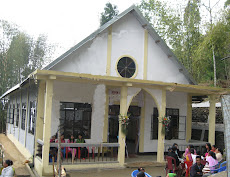





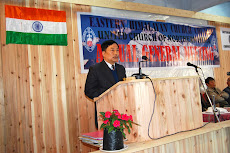







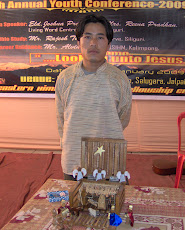











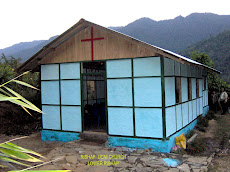


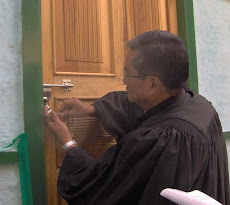





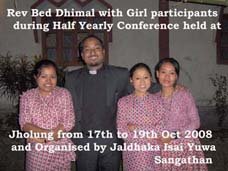



No comments:
Post a Comment